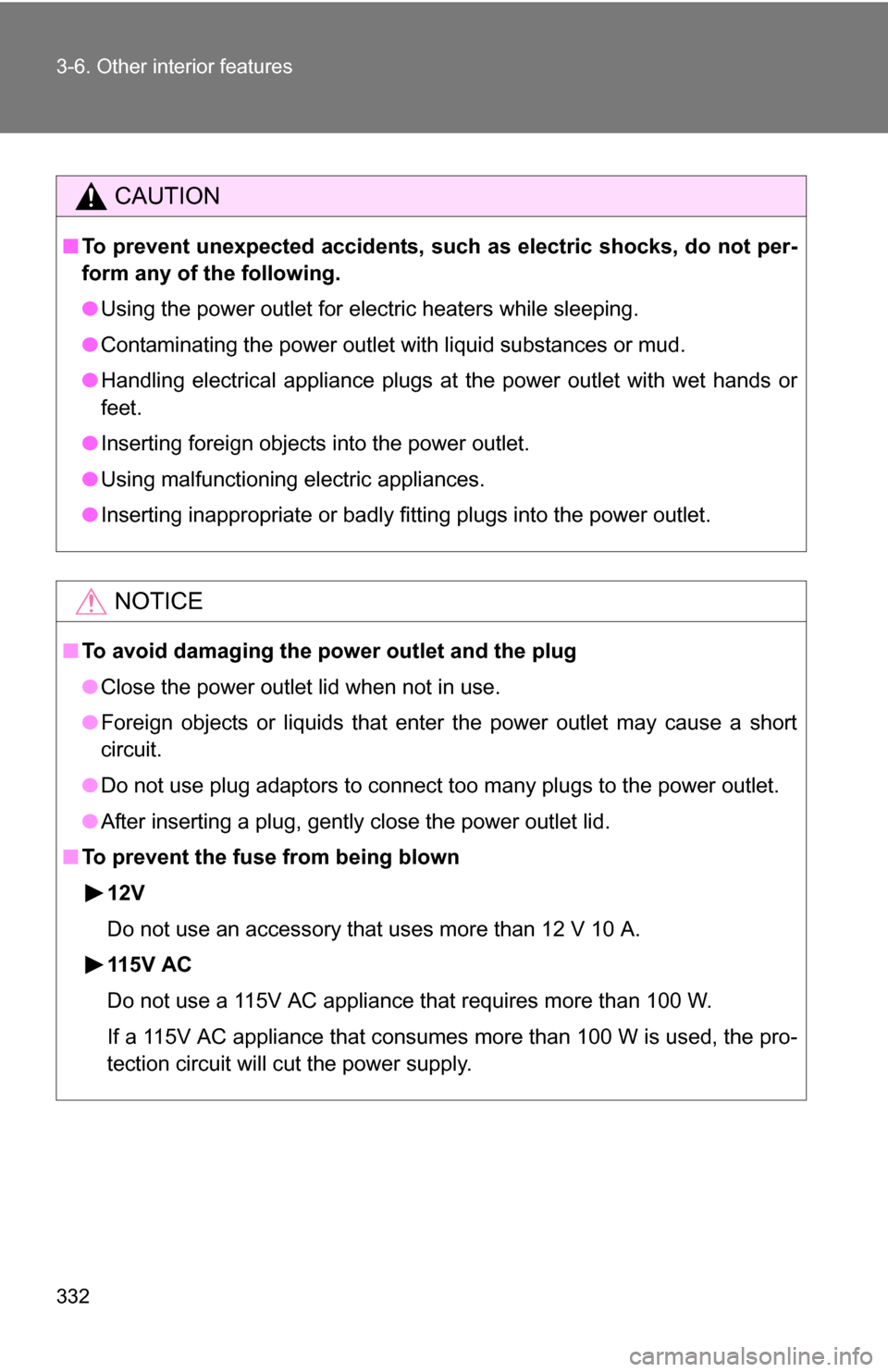Page 4 of 520

TABLE OF CONTENTSIndex
4
• Console box ..................... 312
• Tissue pocket ................... 313
• Trash holder ..................... 314
• Overhead console ............ 316
• Cup holders ...................... 316
• Bottle holders ................... 321
• Auxiliary boxes ................. 322
3-6. Other interior features Sun visors .......................... 323
Vanity mirrors ..................... 324
Clock .................................. 325
Outside temperature display .............................. 326
Rear side-view mirrors ....... 328
Power outlets ..................... 329
Seat heaters ....................... 334
Armrest............................... 336
Floor mat ............................ 337
Luggage compartment features ............................ 338
Garage door opener ........... 345
Compass ............................ 350 4-1. Maintenance and care
Cleaning and protecting the vehicle exterior ................. 356
Cleaning and protecting the vehicle interior .................. 359
4-2. Maintenance Maintenance requirements .................... 362
General maintenance ......... 364
Emission inspection and maintenance (I/M)
programs .......................... 367
4-3. Do-it-yourself maintenance Do-it-yourself service precautions ....................... 368
Hood ................................... 372
Engine compartment .......... 373
Tires.................................... 389
Tire inflation pressure ......... 395
Wheels................................ 398
Air conditioning filter ........... 400
Wireless remote control battery .............................. 402
Checking and replacing fuses ................................. 404
Light bulbs .......................... 415
4Maintenance and care
Page 332 of 520

332 3-6. Other interior features
CAUTION
■To prevent unexpected accidents, su ch as electric shocks, do not per-
form any of the following.
● Using the power outlet for electric heaters while sleeping.
● Contaminating the power outlet with liquid substances or mud.
● Handling electrical appliance plugs at the power outlet with wet hands o\
r
feet.
● Inserting foreign objects into the power outlet.
● Using malfunctioning electric appliances.
● Inserting inappropriate or badly fitting plugs into the power outlet.
NOTICE
■To avoid damaging the power outlet and the plug
●Close the power outlet lid when not in use.
● Foreign objects or liquids that enter the power outlet may cause a short
circuit.
● Do not use plug adaptors to connect too many plugs to the power outlet.
● After inserting a plug, gently close the power outlet lid.
■ To prevent the fuse from being blown
12V
Do not use an accessory that uses more than 12 V 10 A.
115V AC
Do not use a 115V AC appliance that requires more than 100 W.
If a 115V AC appliance that consumes more than 100 W is used, the pro-
tection circuit will cut the power supply.
Page 355 of 520
Maintenance and care4
355
4-1. Maintenance and careCleaning and protecting the vehicle exterior ......... 356
Cleaning and protecting the vehicle interior .......... 359
4-2. Maintenance Maintenance requirements .................. 362
General maintenance....... 364
Emission inspection and maintenance (I/M)
programs........................ 367
4-3. Do-it-yourself maintenance Do-it-yourself service precautions .................... 368
Hood ................................ 372
Engine compartment ........ 373
Tires ................................. 389
Tire inflation pressure ...... 395
Wheels ............................. 398
Air conditioning filter......... 400
Wireless remote control battery ............................ 402
Checking and replacing fuses .............................. 404
Light bulbs........................ 415
Page 368 of 520

368
4-3. Do-it-yourself maintenance
Do-it-yourself ser vice precautions
If you perform maintenance yourself, be sure to follow the correct
procedures as given in these sections.
ItemsParts and tools
Battery condition ( P. 384)•Warm water
• Baking soda
• Grease
• Conventional wrench
(for terminal clamp bolts)
Brake fluid level ( P. 381)• FMVSS No.116 DOT 3 or SAE
J1703 brake fluid
• Rag or paper towel
Engine coolant level ( P. 380)• “Toyota Super Long Life Coolant”
or similar high quality ethylene
glycol based non-silicate, non-
amine, non-nitrite and non-borate
coolant with long-life hybrid
organic acid technology.
U.S.A.:
“Toyota Super Long Life Coolant”
is pre-mixed with 50% coolant
and 50% deionized water.
Canada:
“Toyota Super Long Life Coolant”
is pre-mixed with 55% coolant
and 45% deionized water.
Engine oil level P. 375) • Toyota Genuine Motor Oil or
equivalent
• Rag or paper towel
• Funnel (used only for adding oil)
Fuses ( P. 404)• Fuse with same amperage rating
as original
Page 373 of 520
373
4-3. Do-it-yourself maintenance
4
Maintenance and care
Engine compar tment
4.0 L V6 (1GR-FE) engine
Washer fluid tank (P. 387)
Power steering fluid reservoir ( P. 383)
Engine oil level dipstick ( P. 375)
Engine coolant reservoir ( P. 380)
Engine oil filler cap ( P. 376)Brake fluid reservoir
( P. 381)
Fuse box ( P. 404)
Battery ( P. 384)
Condenser ( P. 381)
Radiator ( P. 381)
Page 374 of 520
374 4-3. Do-it-yourself maintenance
4.7 L V8 (2UZ-FE) engine
Washer fluid tank (P. 387)
Power steering fluid reservoir ( P. 383)
Engine coolant reservoir ( P. 380)
Engine oil level dipstick ( P. 375)
Engine oil filler cap ( P. 376)Brake fluid reservoir
( P. 381)
Fuse box ( P. 404)
Battery ( P. 384)
Condenser ( P. 381)
Radiator ( P. 381)
Page 404 of 520
404
4-3. Do-it-yourself maintenance
Checking and replacing fuses
If any of the electrical components do not operate, a fuse may have
blown. If this happens, check and replace the fuses as necessary.
Turn the engine switch off.
The fuses are located in the following places. To check the
fuses, follow the in structions below.
Engine compartment
Push the tab in and lift the lid
off.
Under the instrument panel Remove the lid.
Page 405 of 520
405
4-3. Do-it-yourself maintenance
4
Maintenance and care
After a system failure, see “Fuse layout and amperage rat-
ings” (
P. 407) for details about which fuse to check.
Remove the fuse with the pull-
out tool.
Check if the fuse has blown.
Ty p e A Normal fuse
Blown fuse
Replace it with one of an
appropriate amperage rating.
The amperage rating can be
found on the fuse box lid.